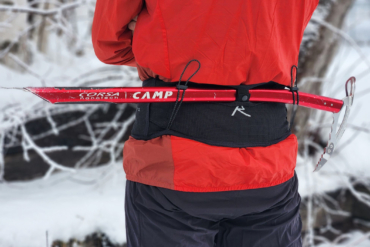Each winter, untold thousands of runners head indoors to train on treadmills and tracks when the temps turn cold. But running outdoors year-round is possible. With the right running apparel and gear, you can make winter running not only bearable but comfortable — in any temperature. Here are 10 tips on how to do winter running right.
1. Trail Shoes
Trail-running shoes with aggressive tread and water-resistant uppers are the preferred footwear for many winter runners. Unlike road shoes, many trail-running models from companies like Montrail, Salomon, La Sportiva, Inov-8, and others protect feet from wind and moisture. Plus, they add grip for variable conditions underfoot — from snow to mud to slush.

La Sportiva Ultranord winterized trail runners (with included gaiters)
2. Add Extra Grip
When rubber tread won’t cut it, runners add grip to their shoes. YakTrax products, popular with many runners, wrap steel coils crisscrossed underfoot for grip. More aggressive, Kahtoola MICROSpikes are an add-on crampon that cinches over a shoe to position 10 stainless steel spikes down off your sole.
3. Head Case
Neck gaiters, hats, balaclavas, and handkerchief-like products including the Original Buff allow for a layering system on your neck, chin, cheeks, and noggin. Start out bundled up, but de-layer once your head gets hot, stowing headwear in a pocket to regulate your entire body’s temperature on the go.
4. Hands and Feet
Extremities often suffer the most while on a run. Some runners wear thin gloves and ball their hands inside until blood flows to the fingers. Mittens with flip-top finger compartments let you balance heat and get quick dexterity when needed. For the feet, waterproof trail-running shoes — which block the wind and keep more heat inside — are adequate for many runners to zero or below.
5. Thin Sheen of Warmth
As Nordic skiers know, a dab of petroleum jelly on exposed skin — especially on the cheeks, lips, and nose — adds an invisible barrier of warmth and protection. A smudge of Vaseline or alternative products like Warm Skin (www.warmskin.com) may let you forgo a face mask or balaclava when the temp is above zero.

Kahtoola MICROSpikes grip crampons
6. Start out Cold
A runner dressed to be comfortable right out the door will soon be too hot. Best to start a run feeling underdressed. Heat generated on the go quickly makes up for layers of clothing you’d regularly wear in winter temps.
7. Night Running
Evening runs are dark in the winter, making clothing with bright colors and reflective properties mandatory gear. Car drivers are not expecting to see a jogger at 8p.m. on a 10-degree night.
8. Layers
Remember, your body generates all the heat it requires to keep itself warm — clothing only helps retain that heat. Layers of clothing — from base-layer long underwater, a mid-layer shirt, and to an outer shell — keeps warm air in and allows a runner to unzip for ventilation or pull off a garment altogether when too warm. Sweat wicks better through a system of layers, keeping moisture off the skin.

Brooks LSD Thermal Winter Running Jacket
9. Heart Rate as Gage
Feet slip on snow, and each mile is harder earned. You will be slower. Monitor your heart rate to assess physical output rather than relying on time. An eight-minute-per-mile runner might slow down to nine minutes or more in winter, though calories burned will be equal or greater, despite a slower pace.
10. Breathable Shell
No matter how cold, your core is almost guaranteed to sweat when you run. A Gore-Tex jacket or other types of waterproof shells, though great on the ski slope, are too clammy for cold-weather running. Look for a wind- and water-resistant shell that banks first on breathability to keep you from clamming up while on a winter run.
—Stephen Regenold writes a daily blog on outdoors gear at www.gearjunkie.com.






